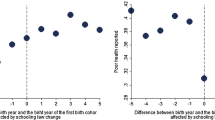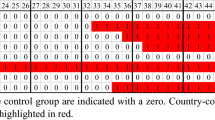Abstract
Many studies suggest that years of formal schooling completed is the most important correlate of good health. There is much less consensus as to whether this correlation reflects causality from more schooling to better health. The relationship may be traced in part to reverse causality and may also reflect “omitted third variables” that cause health and schooling to vary in the same direction. The past three and a half decades have witnessed the development of a large literature focusing on the issue just raised. I deal with that literature and what can be learned from it in this paper.
Similar content being viewed by others
References
Acemoglu, Daron . 1996. A Microfoundation for Social Increasing Returns in Human Capital Accumulation. Quarterly Journal of Economics, 111 (3): 779–804.
Acemoglu, Daron, and Joshua D. Angrist . 2000. How Large are Human-Capital Externalities? Evidence from Compulsory Schooling Laws, in NBER Macroeconomics Annual, Vol. 15, edited by Ben S. Bernanke and Kenneth Rogoff. Cambridge: MIT Press, 9–59.
Angrist, Joshua D., Guido W. Imbens, and Donald B. Rubin . 1996. Identification of Causal Effects Using Instrumental Variables. Journal of the American Statistical Association, 91 (434): 444–472.
Barker, David J.P . 1995. Fetal Origins of Coronary Heart Disease. British Medical Journal, 311: 171–174.
Becker, Gary S . 1965. A Theory of the Allocation of Time. Economic Journal, 75 (299): 493–517.
Becker, Gary S., and Casey B. Mulligan . 1997. The Endogenous Determination of Time Preference. Quarterly Journal of Economics, 112 (3): 729–758.
Behrman, Jere R., and Mark R. Rosenzweig . 2004. Returns to Birthweight. Review of Economics and Statistics, 86 (2): 586–601.
Black, Sandra E., Paul J. Devereux, and Kjell G. Salvanes . 2007. From the Cradle to the Labor Market? The Effect of Birth Weight on Adult Outcomes. Quarterly Journal of Economics, 122 (1): 409–439.
Card, David . 1999. The Causal Effect of Education on Earnings, in Handbook of Labor Economics, Vol. 3, edited by Orley Ashenfelter and David Card. Amsterdam: Elsevier, 1801–1863.
Card, David . 2001. Estimating the Return to Schooling: Progress on Some Persistent Econometric Problems. Econometrica, 69 (5): 1127–1160.
Case, Ann, Angela Fertig, and Christina Paxson . 2005. The Lasting Impact of Childhood Health and Circumstances. Journal of Health Economics, 24 (2): 365–389.
Chou, Shin-Yi, Jin-Tan Liu, Michael Grossman, and Theodore J. Joyce . 2007. Parental Education and Child Health: Evidence from a Natural Experiment in Taiwan. NBER Working Paper No. 13466, Cambridge: National Bureau of Economic Research.
Currie, Janet, and Enrico Moretti . 2003. Mother's Education and the Intergenerational Transmission of Human Capital: Evidence from College Openings. Quarterly Journal of Economics, 118 (4): 1495–1532.
Deaton, Angus . 2002. Policy Implications of the Gradient of Health and Wealth. Health Affairs, 21 (4): 13–30.
De Stavola, Bianca L., Rebecca Hardy, Diana Kuh, Isabel dos Santos Silva, Michael Wadsworth, and Anthony J. Swerdlow . 2000. Birthweight, Childhood Growth, and Risk of Breast Cancer in a British Cohort. British Journal of Cancer, 83 (7): 964–968.
de Walque, Damien . 2005. Education, Information, and Smoking Decisions: Evidence from Smoking Histories, 1940–2000. World Bank Working Paper, Washington, DC.
de Walque, Damien . 2007. How Does the Impact of an HIV/AIDS Information Campaign Vary with Educational Attainment? Evidence from Rural Uganda. Journal of Development Economics, 84 (2): 686–714.
Edwards, Linda N., and Michael Grossman . 1979. The Relationship between Children's Health and Intellectual Development, in Health: What Is It Worth?, edited by Selma J. Mushkin and David D. Dunlop. Elmsford, NY: Pergamon Press, 273–314.
Erbsland, Manfred, Walter Ried, and Volker Ulrich . 1995. Health, Health Care, and the Environment. Econometric Evidence from German Micro Data. Health Economics, 4 (3): 169–182.
Farrell, Phillip, and Victor R. Fuchs . 1982. Schooling and Health: The Cigarette Connection. Journal of Health Economics, 1 (3): 217–230.
Fuchs, Victor R . 1982. Time Preference and Health: An Exploratory Study, in Economic Aspects of Health, edited by Victor R. Fuchs. Chicago: University of Chicago Press, 93–120.
Glied, Sherry, and Adriana Lleras-Muney . 2003. Health Inequality, Education and Medical Innovation. NBER Working Paper No. 9738, Cambridge: National Bureau of Economic Research.
Goldberger, Arthur S . 1974. Unobservable Variables in Econometrics, in Frontiers in Econometrics, edited by Paul Zarembreka. New York: Academic Press, 193–213.
Grossman, Michael . 1972a. On the Concept of Health Capital and the Demand for Health. Journal of Political Economy, 80 (2): 223–255.
Grossman, Michael . 1972b. The Demand for Health: A Theoretical and Empirical Investigation. New York: Columbia University Press for the National Bureau of Economic Research.
Grossman, Michael . 2000. The Human Capital Model, in Handbook of Health Economics, Vol. 1A, edited by Anthony J. Culyer and Joseph P. Newhouse. Amsterdam: Elsevier, 347–408.
Grossman, Michael . 2006. Education and Non-Market Outcomes, in Handbook of the Economics of Education, Vol. 1, edited by Eric Hanushek and Finis Welch. Amsterdam: Elsevier, 577–633.
Jöreskog, Karl G . 1973. A General Method for Estimating a Linear Structural Equations System, in Structural Equations Models in the Social Sciences, edited by Arthur S. Goldberger and Otis D. Duncan. New York: Seminar Press, 85–112.
Jöreskog, Karl G., and Dag Sörbom . 1981. LISREL: Analysis of Linear Structural Relationships by the Method of Maximum Likelihood. Chicago: International Educational Services.
Kenkel, Donald S . 2000. Prevention, in Handbook of Health Economics, Vol. 1B, edited by Anthony J. Culyer and Joseph P. Newhouse. Amsterdam: Elsevier, 1675–1720.
Lleras-Muney, Adriana . 2005. The Relationship between Education and Adult Mortality in the United States. Review of Economic Studies, 72 (1): 189–221.
Michael, Robert T . 1972. The Effect of Education on Efficiency in Consumption. New York: Columbia University Press for the National Bureau of Economic Research.
Michael, Robert T . 1973. Education in Nonmarket Production. Journal of Political Economy, 81 (2, Pt. 1): 306–327.
Mincer, Jacob . 1974. Schooling, Experience, and Earnings. New York: Columbia University Press for the National Bureau of Economic Research.
Rosenzweig, Mark R., and T.Paul Schultz . 1982. The Behavior of Mothers as Inputs to Child Health: The Determinants of Birth Weight, Gestation, and Rate of Fetal Growth, in Economic Aspects of Health, edited by Victor R. Fuchs. Chicago: University of Chicago Press for the National Bureau of Economic Research, 53–92.
Wagstaff, Adam . 1986. The Demand for Health: Some New Empirical Evidence. Journal of Health Economics, 5 (3): 195–233.
Author information
Authors and Affiliations
Rights and permissions
About this article
Cite this article
Grossman, M. The Relationship Between Health and Schooling. Eastern Econ J 34, 281–292 (2008). https://doi.org/10.1057/eej.2008.13
Published:
Issue Date:
DOI: https://doi.org/10.1057/eej.2008.13




